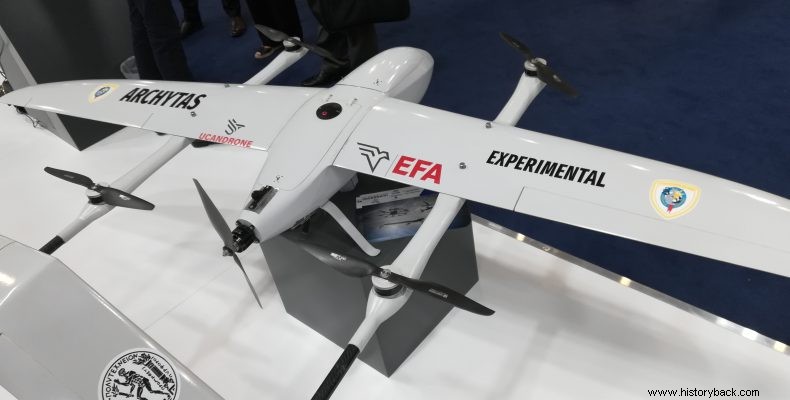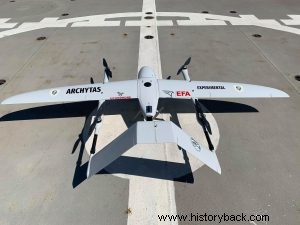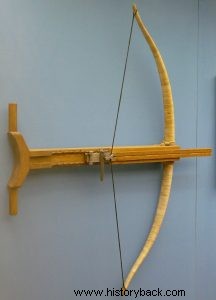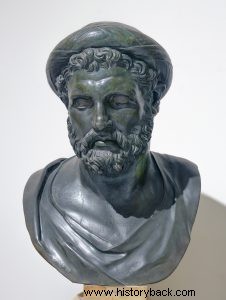
Archytas was born in the Greek city of Taranto in Lower Italy in 428 BC. But other sources state that he was born in 435, 431 or even 410 BC. The last date is probably incorrect. He was a multifaceted personality, Pythagorean philosopher, politician, general, mathematician, inventor and engineer. His famous "Pigeon" was the first "drone" so to speak in history. However, he seems to have participated in the "invention" of catapults.
OF PANTELIS D. KARYKAS
He was a student of Philolaus from Crotona and in turn became the teacher of many. His love of mathematics and engineering led him to discoveries and inventions. But he was also an excellent politician and general. According to the sources, he was elected general of his city, Taranto, 7 times and was never defeated on the battlefield. He was the essential ruler of his city from 380 BC. until his death (in 355, 350 or 347 BC depending on the source) having made his city a regional power capable of fielding 30,000 infantry and 4,000 cavalry, as Strabo testifies.
He was a just ruler so that balance and peace were maintained in his city. Sober and always cool, he was a model and many of his speeches became proverbial phrases in Antiquity. He never punished someone when he was angry. He wrote scientific treatises of which little has survived. He was a great mathematician and even solved the famous "Delion Problem" (Doubling the cube, one of the three well-known problems of antiquity), but he also dealt with astronomy, optics and acoustics.
But he is also considered the father of Engineering. According to Diogenes Laertius he was the first to methodically connect Mechanics with Mathematics. He is considered the inventor of the pulley but also as one of the inventors of catapults.
Regarding the famous "Pigeon", the Roman historian Aulos Gellius, referring to his most ancient sources, states that Archytas built a wooden statue of a dove that flew through a mechanism he had invented using compressed air, probably a type of early 'jet' engine. It is worth noting that even his later Roman writers considered him a great man and scientist.
His reputation remained unaltered in the West and through the Renaissance and great thinkers were inspired by him and even became the hero of a fantasy novel. Even today, Archytas is better known in the West than in Greece, of which he was a child. A crater on the Moon and an asteroid were named after him.
There is no tangible evidence of his contribution to the discovery, or rather, the development of the catapult, but given that the first massive and effective use of catapults was made by Dionysius of Syracuse against the Carthaginians at Motii in 397 BC. "And the catapult was found at this time in Syracuse, as if the state craftsmen were gathered everywhere in one place" (And indeed the catapults were invented at that time in Syracuse, because the best craftsmen had gathered there from everywhere), says Diodorus the Sicilian.
Motyi
At the beginning of the 4th century BC the Greeks of Sicily were fighting once more against their ancient rivals, the Carthaginians. Dionysius of Syracuse, this time wished to prepare the Greek forces as best as possible. But in addition to the classic weapons, the engineers of Dionysius invented a new weapon, the catapult. The catapult was a formidable war machine, capable of piercing through the opponents' shields (the pelts). In its first form it was an anti-personnel weapon, designed specifically against dense flanks. The first catapults were of simple design and construction.
They were called gastrafetes because their operator supported them on his stomach (stomach) during reloading, perhaps also during shooting. Gastrafetes were actually nothing more than large crossbows (crossbows), almost identical to their medieval counterparts. The archer shot a large arrow, with great speed and therefore piercing ability. Its combat range was satisfactory for the time. At the same time, Dionysius ordered the construction of multi-story siege towers, equipped with bridges and catapults, but also larger and more powerful warships, quadrilaterals and pentarilaterals.
When everything was ready, Dionysius moved, in 397 BC, at the head of 80,000 infantry, 3,000 cavalry and for the first time in history hundreds of war machines against Motya, the main base of the Carthaginians in Sicily. The Greeks began the siege of Motya by raising a rampart. But before they completed the work, Carthaginian reinforcements arrived in the city - 100 ships under Imilkona.
But Dionysius manned the ships with many archers and slingers and sent his catapults ashore. Thus the attack of the Carthaginians was easily repulsed, as the arrows of the catapults shattered the opponents and as Diodorus the Sicilian recounts, "this arrow was a great surprise because it was first found at that time".
So the sharp gastraphetes and the surprise they caused to the Carthaginians gave the victory to the Greeks and forced Imilkon to withdraw. Then Dionysios used catapults against the walls, but also his six-story siege towers. Finally the Greeks' machines succeeded in creating a breach in the wall and entered the city. Its defenders, together with the inhabitants, retreated into the city and fortified themselves in the houses, but finally, after a fierce overnight conflict, the city was captured. It is worth noting that Dionysius crucified all the Greek mercenaries of the Carthaginians whom he captured on charges of treason...
The new "Archytas"
The prototype of the first Greek VTOL (vertical take-off) fixed-wing drone named "Archytas", was presented during the interdisciplinary exercise "Parmenion 2021" to the Deputy Minister of National Defense Nikos Hardalia in Chios. "Archytas" which received its name from the ancient Greek general of the same name, inventor, "father of artillery" (he discovered the catapults), politician and philosopher, is a collaboration product of EFA Group and Ucandrone PC in collaboration with the Navy and others research institutions. The drone lands vertically with the help of four electric powered propellers. It has a double vertical fixed V type. It has a landing gear that reduces drag.


Gastrafetis

